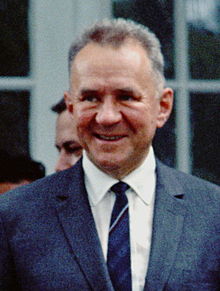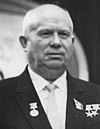| Premier of the Soviet Union | |
|---|---|
| Глава Правительства СССР (Russian) | |
 State Emblem of the Soviet Union State Emblem of the Soviet Union | |
 Longest serving Longest servingAlexei Kosygin 15 October 1964 – 23 October 1980 | |
| Style | Mr. Premier (informal) His Excellency (diplomatic) |
| Type | Head of government |
| Reports to | Supreme Soviet |
| Residence | Kremlin Senate, Moscow |
| Appointer | Supreme Soviet |
| Formation | 6 July 1923; 101 years ago (1923-07-06) |
| First holder | Vladimir Lenin |
| Final holder | Ivan Silayev |
| Abolished | 26 December 1991; 33 years ago (1991-12-26) |
| Succession | Prime Minister of Russia |
| Deputy | First Deputy Premier
Deputy Premier |
The Premier of the Soviet Union (Russian: Глава Правительства СССР) was the head of government of the Union of Soviet Socialist Republics (USSR). From 1923 to 1946, the name of the office was Chairman of the Council of People's Commissars, and from 1946 to 1991 its name was Chairman of the Council of Ministers. During the dissolution of the Soviet Union in 1991, its name was briefly Prime Minister and later Chairman of the Committee on the Operational Management of the Soviet Economy. The first Soviet premier was the country's founder and first leader, Vladimir Lenin. After 1924, when General Secretary of the Communist Party Joseph Stalin rose to power, the de facto leader was the party's General Secretary, with Stalin and his successor Nikita Khrushchev also serving as premier. Twelve individuals held the post.
History
Lenin's First Government was created on 6 July 1923 by the Central Executive Committee with Lenin as its first chairman. The government was empowered to initiate decrees and legislation that were binding throughout the USSR. The longest serving premier in the history of the USSR was Alexei Kosygin, who was appointed head of government after the ousting of Nikita Khrushchev in 1964. However, Kosygin's prestige was weakened when he proposed the economic reform of 1965. In 1991, upon Valentin Pavlov's ascension to the premiership, the Council of Ministers was abolished and replaced with the Cabinet of Ministers. After the August coup of 1991, the majority of the cabinet members endorsed the coup, leading to the Cabinet of Ministers dissolving and being replaced by the Committee on the Operational Management of the Soviet Economy. The government of the Russian Soviet Federative Socialist Republic began seizing Soviet ministries in the aftermath of the coup, and by December 1991 the Soviet government had completely lost control of itself and shut down entirely.
Under the 1977 Soviet Constitution, the head of government was the leader of the highest executive and administrative organ of state. The head of government was appointed by and accountable to the Supreme Soviet (and its Presidium). The head of government was tasked with resolving all state administrative duties within the jurisdiction of the USSR to the degree which were not the responsibility of the Supreme Soviet or its Presidium. The head of government managed the national economy, formulated the five-year plans and ensured socio-cultural development. It functioned as the most influential office of government and nominally the most influential office until the establishment of the Office of the President of the Soviet Union in 1990.
Vladimir Lenin and Joseph Stalin died in office of natural causes, and three premiers resigned—Alexei Kosygin, Nikolai Tikhonov and Ivan Silayev. Another three were concurrently party leader and head of government (Lenin, Stalin and Nikita Khrushchev). The one who spent the shortest time in office was Ivan Silayev, at 119 days. Kosygin spent the longest time in office—16 years.
List of officeholders
| No. | Portrait | Name (Birth–death) |
Term | Electorate | Cabinets | Ref. | ||
|---|---|---|---|---|---|---|---|---|
| Took office | Left office | Duration | ||||||
| 1 |
 | Vladimir Lenin (1870–1924) | 6 July 1923 | 21 January 1924 † | 228 days | – | Lenin I–II | |
| 2 |
 | Alexei Rykov (1881–1938) | 2 February 1924 | 19 December 1930 | 6 years, 320 days | 1924 1925 1927 1929 | Rykov I–II–III–IV–V | |
| 3 |
 | Vyacheslav Molotov (1890–1986) | 19 December 1930 | 6 May 1941 | 10 years, 138 days | 1931 1935 1936 1937 | Molotov I–II–III–IV | |
| 4 |
 | Joseph Stalin (1878–1953) | 6 May 1941 | 5 March 1953 † | 11 years, 303 days | 1946 1950 | Stalin I–II–III | |
| 5 |
 | Georgy Malenkov (1902–1988) | 6 March 1953 | 8 February 1955 | 1 year, 339 days | 1954 | Malenkov I–II | |
| 6 |
 | Nikolai Bulganin (1895–1975) | 8 February 1955 | 27 March 1958 | 3 years, 47 days | 1958 | Bulganin | |
| 7 |
 | Nikita Khrushchev (1894–1971) | 27 March 1958 | 15 October 1964 | 6 years, 202 days | 1962 | Khrushchev I–II | |
| 8 |
 | Alexei Kosygin (1904–1980) | 15 October 1964 | 23 October 1980 | 16 years, 8 days | 1966 1970 1974 1979 | Kosygin I–II–III–IV–V | |
| 9 |
 | Nikolai Tikhonov (1905–1997) | 23 October 1980 | 27 September 1985 | 4 years, 339 days | 1984 | Tikhonov I–II | |
| 10 |
 | Nikolai Ryzhkov (1929–2024) | 27 September 1985 | 14 January 1991 | 5 years, 109 days | 1989 | Ryzhkov I–II | |
| 11 |
 | Valentin Pavlov (1937–2003) | 14 January 1991 | 28 August 1991 | 226 days | – | Pavlov | |
| 12 |
 | Ivan Silayev (1930–2023) | 28 August 1991 | 25 December 1991 | 119 days | – | Silayev | |
See also
| Politics of the Soviet Union | ||||||
|---|---|---|---|---|---|---|
 | ||||||
| Leadership | ||||||
Communist Party
|
||||||
Legislature
|
||||||
Governance
|
||||||
| Judiciary | ||||||
|
Ideology |
||||||
Society
|
||||||
|
| ||||||
- Bibliography of the Russian Revolution and Civil War § Government
- Bibliography of Stalinism and the Soviet Union § Government
- Bibliography of the Post Stalinist Soviet Union § Government
- Deputy Premier of the Soviet Union
- First Deputy Premier of the Soviet Union
- List of heads of state of the Soviet Union
- List of leaders of the Soviet Union
Notes
- These numbers are not official.
- On August 19, 1991, due to the illness of Valentin Pavlov, the duties of the head of the government of the USSR were assigned to First Deputy Prime Minister Vitaly Doguzhiyev.
References
Citations
- Центральный Исполнительный Комитет съезда Советов. Статья №38 от Декабрь 1977 «Суверенные права союзных республик». (Central Executive Committee of the Congress of Soviets. Article #38 of December 1924 Sovereign Rights of the Member Republics. ).
- Brown 2009, p. 403.
- Ferdinand 1993, p. 133.
- Верховный Совет СССР. Федеральный конституционный закон №130 от 7 октября 1977 «Совета Министров СССР». (Supreme Soviet of the Soviet Union. Article #130 of 7 October 1977 The Council of Ministers of the USSR. ).
- Верховный Совет СССР. Федеральный конституционный закон №131 от 7 октября 1977 «Совета Министров СССР». (Supreme Soviet of the Soviet Union. Article #131 of 7 October 1977 The Council of Ministers of the USSR. ).
- Cull, Culbert & Welch 2003, p. 182.
- Phillips 2000, p. 82.
- Phillips 2000, p. 89.
- Totten & Bartrop 2008, p. 76.
- ^ Duiker & Spielvogel 2006, p. 572.
- Trahair & Miller 2004, p. 69.
- Trahair & Miller 2004, p. 37.
- ^ Ploss 2010, p. 219.
- Валентин Сергеевич Павлов [Valentin Sergeyevich Pavlov] (in Russian). RU: Hrono. Retrieved 6 December 2010.
- Иван Степанович Силаев [Ivan Stepanovich Silayev] (in Russian). RU: Hrono. Retrieved 6 December 2010.
Sources
- Brown, Archie (2009). The Rise & Fall of Communism. Bodley Head. ISBN 978-0061138799.
- Bonnell, Victoria; Cooper, Ann (1994). Russia at the Barricades: Eyewitness Accounts of the August 1991 coup. M.E. Sharpe. ISBN 978-1563242717.
- Coppa, Frank (2006). Encyclopedia of Modern Dictators: From Napoleon to the Present. Peter Lang. ISBN 978-0820450100.
- Cull, Nicholas; Culbert, David; Welch, David (2003). Propaganda and Mass Persuasion: A Historical Encyclopedia, 1500 to the Present. ABC-CLIO. ISBN 978-1576078204.
- Duiker, William; Spielvogel, Jackson (2006). The Essential World History. Cengage Learning. ISBN 978-0495902270.
- Dyker, David (1992). Restructuring the Soviet economy (1st ed.). Routledge. ISBN 978-0415067614.
- Fainsod, Merle; Hough, Jerry F. (1979). How the Soviet Union is Governed. Harvard University Press. ISBN 978-0674410305.
- Ferdinand, Maria Feldbrugge Joseph (1993). Russian Law: The End of the Soviet System and the Role of Law (1st ed.). Springer Publishing. ISBN 978-0792323587.
- Garcelon, Marc (2005). Revolutionary Passage: From Soviet to Post-Soviet Russia, 1985–2000. Temple University Press. ISBN 978-1592133628.
- Harris, Jonathan (2005). Subverting the System: Gorbachev's Reform of the Party's Apparat, 1986–1991. Rowman & Littlefield. ISBN 978-0742526792.
- Kotz, David Michael; Weir, Fred (2007). Russia's Path from Gorbachev to Putin: The Demise of the Soviet System and the New Russia (2nd ed.). Taylor & Francis. ISBN 978-0415701471.
- Phillips, Steven (2000). Lenin and the Russian Revolution. Heinemann. ISBN 978-0-435-32719-4.
- Ploss, Sidney (2010). The Roots of Perestroika: The Soviet Breakdown in Historical Context. McFarland & Company. ISBN 978-0786444861.
- Rappaport, Helen (1999). Joseph Stalin: A Biographical Companion. ABC-CLIO. ISBN 978-1576070840.
- Sebag-Montefiore, Simon (2005). Stalin: The Court of the Red Tsar. Vintage Books. ISBN 978-1400042302.
- Service, Robert (2000). Lenin: A Biography. Belknap Press of Harvard University Press. ISBN 978-0674008281.
- Service, Robert (2009). History of Modern Russia: From Tsarism to the Twenty-first Century. Penguin Books Ltd. ISBN 978-0674034938.
- Service, Robert (2005). Stalin: A Biography. Harvard University Press. ISBN 978-0674016972.
- Totten, Samuel; Bartrop, Paul (2008). Dictionary of Genocide: A–L. Vol. 1. Greenwood Publishing Group. ISBN 978-0313346422.
- Trahair, Richard; Miller, Robert (2004). Encyclopedia of Cold War Espionage, Spies, and Secret Operations. Greenwood Publishing Group. ISBN 978-1929631759.
- Young, Gregory; Braden, Nate (2005). The Last Sentry: The True Story That Inspired the Hunt for Red October. Naval Institute Press. ISBN 978-1591149927.
- Zemtsov, Ilya (1989). Chernenko, the Last Bolshevik: The Soviet Union on the eve of Perestroika. Transaction Publishers. ISBN 978-0887382604.
| Premiers of the Soviet Union | |
|---|---|
| Premiers | |
| First Deputies |
|
| People from Russia | |||||
|---|---|---|---|---|---|
| Political leaders |
| ||||
| Military figures and explorers | |||||
| Scientists, engineers and inventors | |||||
| Artists and writers | |||||
| Religious leaders | |||||
| Sportspeople | |||||
| Heads of state and government of Europe | |||||||
|---|---|---|---|---|---|---|---|
| Heads of state |
| ||||||
| Heads of government |
| ||||||
| |||||||